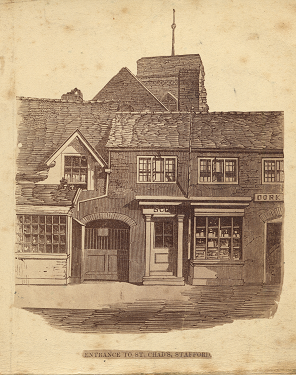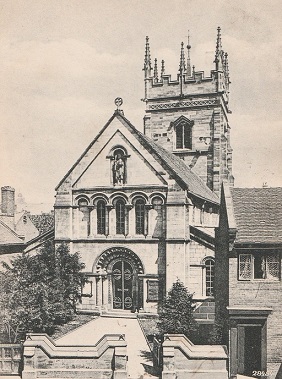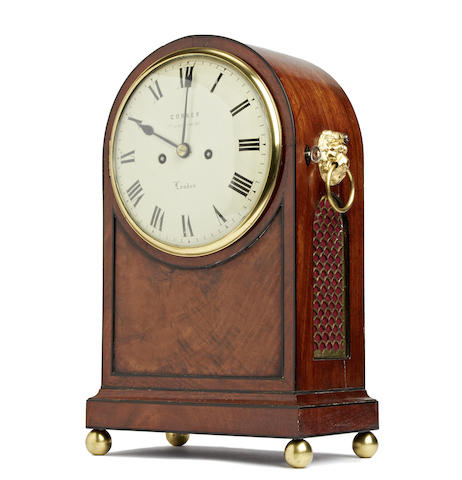| Home |
| The Corker Family |
| Clock & Watch Makers of Staffordshire and London |
John Corker and Rosamond Poynton were married on 10 October 1725 at the village of Hanbury located near the River Dove that forms the boundary between the counties of Staffordshire and Derbyshire. Heading upstream, in a north-westerly direction, the River Dove passes by the town of Uttoxeter, on the Staffordshire side, where the newlywed couple established their home.
John Corker founded a business as a cork-cutter in the town centre of Uttoxeter. Cork, imported into England, was cut for a variety of uses including bottle stoppers and inner soles for shoes. It seems to be a coincidence that the Corker name matched the occupation.
The parish register of St Mary the Virgin’s Church, Uttoxeter, recorded the baptisms of nine daughters and four sons of John and Rosamond Corker. The youngest child, named Daniel Corker, was baptised on 19 April 1750. His wedding to Sarah Matthews took place at Uttoxeter on 12 December 1773. The marriage licence gave the information that Daniel Corker’s profession was a cork-cutter.
Daniel and Sarah Corker made their family home in Uttoxeter. Possibly Daniel Corker became a partner in the cork-cutting business operated by his father in Market Place, Uttoxeter (1).
When Daniel Corker died in 1787, at the young age of 36, his oldest son John was 12 years old and his youngest son Daniel had just had his first birthday. His widow Sarah Corker, who lived to the age of 83, was buried on 9 January 1828 at St Mary’s Church, Stafford, the county town of Staffordshire. Her will named four surviving sons: John, Thomas, Joseph, and Daniel, and one daughter, Rosamond, the wife of William Matthews (2). Her son Nathaniel Corker had predeceased her. Another son had died in infancy.
None of the Corker boys became cork-cutters – the trade of their father and Corker grandfather – they all trained for other professions.
Joseph Corker set up business as a whitesmith (a craftsman who may work with tin, silver, pewter and other metals) in Market Place, Ashby-de-la-Zouch, Leicestershire (3). In the 1861 census he was aged 81 living at Pegg’s Yard, Market Street, Ashby-de-la-Zouch. The census return reported that his birthplace was Uttoxeter, Staffordshire.
Three brothers of Joseph Corker – John, Thomas and Daniel – all qualified as watchmakers.
John Corker provided services as a watchmaker, jeweller and silversmith in the Staffordshire town of Newcastle-under-Lyme. He kept ties to his hometown of Uttoxeter. An elaborate monument to commemorate his family was installed in the churchyard of St Mary the Virgin’s Church, Uttoxeter (An Old Churchyard Memorial at St Mary's Church, Uttoxeter).
In 1792 Thomas Corker was apprenticed as a ‘watch finisher’ to the master James Hartwell of Uttoxeter (4). Thomas Corker married Sarah Ray, the daughter of the shoemaker Sam Ray, on 23 August 1807 at St Mary’s Church in Sarah’s hometown of Stafford. At the same church, nine children of Thomas and Sarah Corker were baptised (5). A trade directory for 1818 had an entry for Thomas Corker, clock and watchmaker, Greengate Street, Stafford (6).
In the 1841 census, Thomas Corker, living with his wife Sarah and five of
their children, was still thriving as a watchmaker in Greengate Street, Stafford.
Thomas Corker, aged 66, was buried on 9 April 1843 at St Mary’s Church,
Stafford. Two of his sons, John Corker born in 1812 and Thomas Corker born in
1814, carried on the family business. An 1851 directory for the town of
Stafford listed the clock and watchmaker brothers:
John Corker, 15 Greengate Street, and
Thomas Corker, 31 Greengate Street (7).
A notice of business closing was printed in the Staffordshire Advertiser on 8 May 1869: (8)
|
Borough of Stafford – Clock and Watch Maker's Business.
To be disposed of, the business of a Clock and Watch Maker, for 50 years carried on in Greengate Street, Stafford. Given up in consequence of the illness of the proprietor. For particulars and to treat, apply to Mr. Corker, Greengate Street, Stafford. |
John Corker, watchmaker of Stafford, passed away on the same day as the newspaper notice (9). He was predeceased by his watchmaker brother Thomas who was buried on 5 May 1854 at St Mary’s Church, Stafford.
| Row of shops at the Greengate Street Entrance
to St Chad’s Church, Stafford, about 1860. |
 |
|
The shop cut-off at the right was the business of
John Corker, Clock and Watch Maker. In the background, peering above the shop roofs, is the tower of St Chad’s Church. Photograph from the 1870s of an engraved print made in about 1860 (Staffordshire Archives, Gateway to the Past, Object Number: P87.111.0154). More history of the Greengate Street shops is here. |
The row of shops shown in the old print was later demolished to open up an improved entrance to St Chad’s Church (10), as shown in the photograph below.

St Chad’s Church, Stafford,
|
In the 24 April 1852 edition of the weekly journal Household Words Charles Dickens, then aged 40 and an established author, wrote about a trip he made to Stafford. He did not have very kind words to say about the town: ‘I find it to be by no means a lively town. In fact it is as dull and dead a town as any one could desire not to see.’ He stayed for the night at the Swan Hotel on Greengate Street, directly across from the clock and watchmaker’s shop of John Corker. In observing the shop, Dickens surmised that ‘all the clocks and watches must be stopped, I am sure, for they could never have the courage to go [in this dead town]’ (11).
London
The two Corker brothers, Nathaniel and Daniel, ventured to the great metropolis of London where they married two sisters, the daughters of Samuel Shipston and his wife Jane. Nathaniel Corker married Sarah Shipston in 1808. Three years later, in 1811, Nathaniel’s younger brother Daniel Corker married Sarah’s sister Elizabeth Shipston. Both weddings took place at the London church of St Katherine Coleman.
In 1808 Nathaniel Corker was running a business as a ‘hair dresser and dealer in perfumery’ at the address 10 King’s Place, Commercial Road (12). Commercial Road, in the east end of London, laid out in 1803, was built through open fields from Whitechapel to Limehouse to connect the recently opened West India Docks to the City of London (13). King’s Place was a block on the south side of the western end of Commercial Road at the cross street of Batty Street.
The block opposite King’s Place, on the north side of Commercial Road, named Langley Place, was where Daniel Corker established a clock and watchmaker’s shop, located near Greenfield Street which ran north of Commercial Road (14).
Robson’s London Directory for 1820 listed: (15)
| D. Corker | watch & clock maker | 18 Commercial Rd, Whitechapel [18 Langley Place] |
| Nathaniel Corker | ornamental hair manufa. | 10 Commercial Rd, Whitechapel [10 King’s Place] |
A London street map
dated 1868  marks both Langley Place and
King’s Place. These names were later abolished and
an orderly system of new numbers were assigned to the shops and houses along
Commercial Road.
marks both Langley Place and
King’s Place. These names were later abolished and
an orderly system of new numbers were assigned to the shops and houses along
Commercial Road.
|
Nathaniel Corker’s trade card, early 1800s,
The trade card gave his shop address as ‘54, West-end of Commercial Road, London’. Possibly he then relocated, a few doors away, to ‘10 Commercial Rd, Whitechapel’, which was Nathaniel Corker’s address in Robson’s London Directory for 1820 (or the building was renumbered). The trade card has a nautical theme, with an anchor in the foreground and a sailing ship in the background. Possibly this reflects that daily life in the Commercial Road area was connected to the London docks. A similar trade card design was used for Hill’s ‘Ornamental Hair Warehouse: ladies & gentlemens hair cut & dressed in a peculiar style of elegance; perfumery &c &c.’ located at 172 Aldersgate Street, and 101 Cheapside, London (16). An historian remarked that ‘hair, real and assumed, was big business at the end of the eighteenth century’; specialties were ‘Tetes’ – the high, elaborately ornamented hairstyle for ladies, and ‘Cushions’ – light feather pillows inserted within the ‘Tetes’ to give them body (17). Corker’s trade card informed that he was ‘from Rosses’. This suggests that he may have been trained by Alexander Ross who was listed in the 1802 Post Office London Directory as a ‘perfumer & ornamental hair manufacturer’ at 119 Bishopsgate-Within (18). Nathaniel Corker died aged 40; he was buried at St George-in-the-East, London on 28 December 1822. Just seven months earlier, on 30 May, his eldest child, Nathaniel Shipston Corker, had turned 13 years old. Without a father to guide him, his mother may have decided that, rather than training in the arts of hair dressing like his father, he should adopt the trade of his watchmaker uncle Daniel Corker. |
Daniel Corker’s sons and nephew continued in the watchmaking trade. In December 1823 his nephew Nathaniel Shipston Corker, aged 14, became an apprentice watchmaker to Thomas Drysdale who was a member of the Goldsmith’s Company of London (19).
Britten’s index of Former Clock & Watchmakers and Their Work, published in 1894, included the London names:
| Daniel Corker | 18 Commercial Road, Whitechapel | 1820 |
| Daniel Corker | 18 Langley Place, Commercial Road | 1835–1842 |
| Nathaniel Corker | 48 South Moulton [Molton] Street | 1842 |
The two entries for Daniel were the same Daniel Corker born in Uttoxeter. Nathaniel was Daniel’s nephew.
|
Daniel Corker, aged 74, passed away in January 1860. He had been a clock and watchmaker at 18 Langley Place, Commercial Road for over 45 years (20). He was buried in the family plot at Tower Hamlets Cemetery on Friday, 3 February 1860 (21).
In the 1850s Daniel’s son Edward Samuel Corker, also a skilled watchmaker, lived with his wife Mary Ann and young children in the Commercial Road area near his parents. The Corker children were christened at St Dunstan’s Church, Stepney.
On census day 7 April 1861 Edward Samuel Corker was now the head of the watchmaking business his father had operated at 18 Langley Place, Commercial Road. His sister Sarah and brother Alfred, both unmarried, were also living at home. A short time later, Edward and his family moved a short distance further east to 16 Warkworth Terrace, on the north side of Commercial Road at the cross street of Margaret Street (later renamed to Lowell Street) – just east of where Regent’s Canal connects to Limehouse Basin.
In the 1860s Edward’s cousin Nathaniel Shipston Corker could be found at his watchmaking shop on Kensington High Street in west London (22).
Daniel Shipston Corker, the older brother of Edward Samuel Corker, became the proprieter of a watchmaker’s shop on the High Street, Tooting-Graveney, where he and his wife Emily raised their family. Tooting-Graveney, also known as Lower Tooting, is now part of the borough of Wandsworth in south London. Over the years 1850 to 1891 Daniel Shipston Corker had a succession of appointments, not all consecutively, as the ‘clock-winder’ for Tooting-Graveney. His duties were ‘to keep wound and in good repair the tower and gallery clock’ (23).
The Corker brothers established their London businesses in Commercial Road in the early 1800s when the area was developing as a vibrant community. Their descendants moved on to other neighbourhoods in what is now Greater London. A portrayal of life in the Commercial Road district of nineteenth century London was provided in an article written in 1932:
For a generation all went well, and the appearance of the shops betokened the general prosperity . . . . The generation that saw the Commercial Road in its brightest days passed away, and another followed that found it no longer attractive as domestic life in the locality became less and less associated with the sea. The character of the population altered, the parochial mind changed from one of pride and interest to one of indifference (24).
On 30 September 1888, the body of the victim of a gruesome murder was discovered about one block south of the shop on Commercial Road, Whitechapel where Nathaniel Corker had plied his trade as a hairdresser. By this time the Corker family had left the Whitechapel area. The murder victim was identified as Elizabeth Stride who is believed to have been targeted by the infamous serial killer, Jack the Ripper (25).
More Corker Family History
- The Corker Cork-Cutters
- An Old Churchyard Memorial at St Mary's Church, Uttoxeter
- The Corker Family in Census Returns
- Outline Descendant Tree
Notes
(1)
Francis Redfern, History and antiquities of the town and neighbourhood
of Uttoxeter, 1886, pp. 236–7
(Internet Archive  )
states: ‘The family of Corker owned property in Uttoxeter
Market Place, now in the possession of Mr. Fearn’.
)
states: ‘The family of Corker owned property in Uttoxeter
Market Place, now in the possession of Mr. Fearn’.
In the 1881 census, Francis Fearn, aged 45, was living at Market Place,
Uttoxeter with his wife Elizabeth and sons John and Francis,
His profession was ‘stamp distributor (and grocer)’.
(2) The will of Sarah Corker, probated in the Prerogative Court of Canterbury on 1 February 1828, images online provided by The National Archives, London and the Ancestry website.
(3) History, gazetteer, and directory of Leicestershire, 1846, compiled by William White (Google Book online).
(4) Apprentices of Great Britain, Society of Genealogists.
(5)
Staffordshire Parish Register Collection, FindMyPast website.
Family information for the the betrothed couple was given in a marriage
licence for Thomas Corker and Sarah Ray issued on 23 August 1807
(Staffordshire, Dioceses of Lichfield & Coventry Marriage Allegations and
Bonds, FindMyPast website).
(6) Staffordshire general & commercial directory, 1818, compiled by W. Parson and T. Bradshaw (Google Book online). This directory also named Samuel Ray, shoemaker, Greengate Street, Stafford. Possibly he was the father-in-law of Thomas Corker.
(7) History, Gazetteer & Directory of Staffordshire, 1851, compiled by William White.
(8) Historical British Newspapers, FindMyPast website.
(9)
Index to
UK Wills and Probate 1858–1996 
(10) Information kindly provided by email, July 2018, from William J Read of the Stafford Historical & Civic Society. He stated that the buildings may have been demolished at the end of the 19th century – an ordnance survey map of the early 20th century shows the buildings are no longer there.
(11)
Will Swales, The Swan Stafford: A Brief History, 2019,
pp. 20–21 (accessed online); and
Charles Dickens,
Household
Words, 24 April 1852  ,
Dickens Journals Online.
,
Dickens Journals Online.
(12) Insurance records of the Sun Fire Office, London Metropolitan Archives, The National Archives online catalogue.
(13)
Wapping and Limehouse  , The London
Docklands Development Corporation.
, The London
Docklands Development Corporation.
(14)
An insurance policy dated 13 July 1812 for Daniel Corker, watchmaker,
‘18 near Greenfield Street, Commercial Road’
is in the records of the Sun Fire Office, London Metropolitan Archives;
in the online catalogue of
The National
Archives  , reference: MS 11936/455/871826.
, reference: MS 11936/455/871826.
(15) London City Directories, London Metropolitan Archives and Guildhall Library, hosted by Ancestry.
(16)
Trade
card of Hill  , hairdresser, ca. 1820
(from the Heal Collection, British Museum, Museum number Heal,71.16).
, hairdresser, ca. 1820
(from the Heal Collection, British Museum, Museum number Heal,71.16).
(17)
Curator’s comments to accompany an advertisement for a hair dresser in
the collections of the
British
Museum  , Museum number D,2.3319.
, Museum number D,2.3319.
(18)
Documentation to accompany a print in the collections of the
British
Museum  , Museum number Heal,Topography.390.
, Museum number Heal,Topography.390.
(19) Freedom of the City Admission Papers, London Metropolitan Archives, Ancestry website.
(20) Daniel Corker was established at Langley Place by at least 1812 when a fire insurance policy was issued for his shop (see note above).
(21) Tower Hamlets Cemetery Registers, Ancestry website.
(22) The Goldsmiths’, jewellers’, silversmiths’, watchmakers’, opticians’, and cutlers’ directory for London, 1863 (Google Book online).
(23)
William Edward Morden, The History of Tooting-Graveney, 1897, p. 334
(Internet Archive  ).
).
(24)
Sydney Maddocks, ‘Commercial Road’,
The Copartnership Herald, Vol. II, no. 21, November 1932
(online
article  ).
).
(25)
A study of Elizabeth Stride  documents that her body was found
in Dutfield’s Yard off Berner Street, now named Henriques Street.
documents that her body was found
in Dutfield’s Yard off Berner Street, now named Henriques Street.
Copyright © Diana Whistler, 2024.

